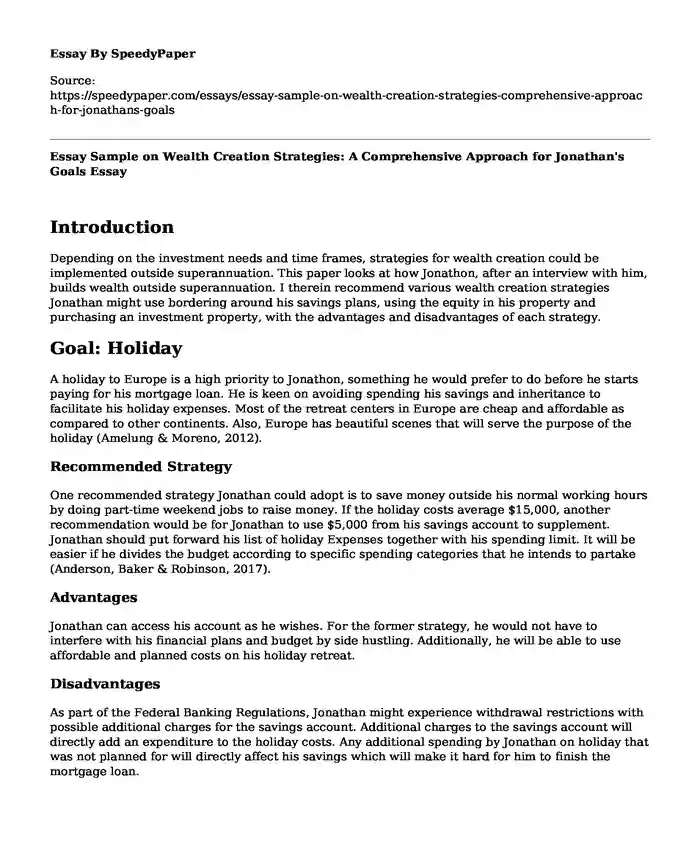Introduction
Depending on the investment needs and time frames, strategies for wealth creation could be implemented outside superannuation. This paper looks at how Jonathon, after an interview with him, builds wealth outside superannuation. I therein recommend various wealth creation strategies Jonathan might use bordering around his savings plans, using the equity in his property and purchasing an investment property, with the advantages and disadvantages of each strategy.
Goal: Holiday
A holiday to Europe is a high priority to Jonathon, something he would prefer to do before he starts paying for his mortgage loan. He is keen on avoiding spending his savings and inheritance to facilitate his holiday expenses. Most of the retreat centers in Europe are cheap and affordable as compared to other continents. Also, Europe has beautiful scenes that will serve the purpose of the holiday (Amelung & Moreno, 2012).
Recommended Strategy
One recommended strategy Jonathan could adopt is to save money outside his normal working hours by doing part-time weekend jobs to raise money. If the holiday costs average $15,000, another recommendation would be for Jonathan to use $5,000 from his savings account to supplement. Jonathan should put forward his list of holiday Expenses together with his spending limit. It will be easier if he divides the budget according to specific spending categories that he intends to partake (Anderson, Baker & Robinson, 2017).
Advantages
Jonathan can access his account as he wishes. For the former strategy, he would not have to interfere with his financial plans and budget by side hustling. Additionally, he will be able to use affordable and planned costs on his holiday retreat.
Disadvantages
As part of the Federal Banking Regulations, Jonathan might experience withdrawal restrictions with possible additional charges for the savings account. Additional charges to the savings account will directly add an expenditure to the holiday costs. Any additional spending by Jonathan on holiday that was not planned for will directly affect his savings which will make it hard for him to finish the mortgage loan.
Alternative Recommendation
Jonathan may as well use his life insurance savings to finance the holiday expense. Jonathan can also plan the holiday idea with his friends in a way that he makes the retreat share spending with his friends. Shared spending will be cheaper, and affordable compared to one person's spending hence the budgeted amount on holiday will have a balance that he can use on other expenses (Hills & Morris, 2018).
Goal: Housing
From the interview with Jonathon, he intends to build savings for purchasing a new home. Jonathan wishes to build a modern furnished home that will house him for many years.
Recommended Strategy
The recommended strategy here is to make a 20% deposit to avoid the mortgage insurance for lenders and an additional $5,000 to cater for legal fees and extra costs. Based on Future Value (FV) calculation:
20% * $450,000 (expected house value) = $90,000
$95,000 * 5 years= $475,000. The interest rate is $25,000 spread over 5 years.
Advantages and Disadvantages
The greatest advantage is that housing keeps appreciating and will be more valuable in the future (Brown, Guin, & Morkoetter, 2014). In case Jonathan wishes to sell the house in the future, it will have an added profit compared to the time it was built. The downside is that Jonathan could bear huge debt over time, whose security is on his property (Scott, M. G., et al., 2018).
Alternative Strategy
An alternative would be to make a one-off payment of $450,000 after making enough savings to save him interest costs and spread the debt burden. It will be easier if he reduces his spend on luxury and puts the costs on a savings plan that will enable him to pay the total one-off deposit
Reference
Amelung, B., & Moreno, A. (2012). Costing the impact of climate change on tourism in Europe: results of the PESETA project. Climatic Change, 112(1), 83-100.
Anderson, A., Baker, F., & Robinson, D. T. (2017). Precautionary savings, retirement planning and misperceptions of financial literacy. Journal of financial economics, 126(2), 383-398.
Brown, M., Guin, B., & Morkoetter, S. (2014). Deposit withdrawals from distressed commercial banks. Unpublished working paper. University of St. Gallen.
Hills, G. E., & Morris, M. H. (2018). Entrepreneurship education: a conceptual model and review. In Educating entrepreneurs for wealth creation (pp. 38-53). Routledge.
Scott, M. G., Klandt, H, & Rosa P. (Eds.). (2018). Educating entrepreneurs for wealth creation. Routledge.
Cite this page
Essay Sample on Wealth Creation Strategies: A Comprehensive Approach for Jonathan's Goals. (2023, Nov 16). Retrieved from https://speedypaper.net/essays/essay-sample-on-wealth-creation-strategies-comprehensive-approach-for-jonathans-goals
Request Removal
If you are the original author of this essay and no longer wish to have it published on the SpeedyPaper website, please click below to request its removal:
- Comparison Essay Example: Islamic and Conventional Banking System
- Free Essay on College Credit
- Marketing Essay Sample: New Product to the Market: Cheap Group Holiday Safari Travel
- Essay Example on Legal Form of Business
- Paper Example on Supporting the Use of Cash Flow Sensitivity
- Free Essay Example: Personnel Budgeting, Planning and Productivity
- Paper Example - American Industries
Popular categories





